| Part 5 Erfoud, Sahara Desert |
|
|
Friday, November 16. The 6th day.
We got up at 3:30 in the dead of night at the hotel Salam in Erfoud.
When we got out of the hotel just after 4:00, the dark sky was full of
stars. It was a star-spangled sky.
A tour member of my age came to my side and pointing upward said "It
is the Big Dipper." I looked up and managed to identify it.
He talks rather to himself, "That is the North Star called Polaris,
and the tip of the handle of the Little Dipper, should be ....." Whatever
he says, I only nod and nod. It seems the brilliant stars are comforting
me.
|
|
 |
|
|
We, tourism members, started from the hotel riding in 6 four-wheel-drive
station wagons.
We are going to watch the sunrise at Maghreb. The word Maghreb seems perverted,
because it means the land of West Sunset.
The 30-minute drive was too tough until reaching the place "Merzouga
large sand dune". The wagon dashed on the debris wilderness with no
road and jolted violently all through. We, on the rear seat, were forcibly
swung vertically and sideways. Without a seat belt, what would have happened?
The 6 wagons avoided violent dust from the front one and ran relying on
their headlights in the total darkness, approaching and separating each
other repeatedly. And finally some prospective light appeared faraway.
|
|
 |
|
|
Sahara Desert, the world largest desert, lies in the northern part of the
African Continent. It is 5,600 km east-west, and 1,700 km north-south.
It is the territory of so many countries as Morocco, Egypt, Tunisia, Libya,
Algeria, West Sahara, Mauritania, Mali, Niger, Chad and Sudan. "Sahara"
means a desert in the Arabian language.
The area is about 10 million square km, nearly one thirds of the African
Continent, which, needless to say, shows this present place is far less
than a needle hole. It is also called Shebi large sand dune, a perfect
sand desert.
10 people rode on camels and the rest of us walked from here.
We are realizing "The cold country with the hot sunshine" for
the first time. Like other members, our couple wear thick scarf and gloves
with long underpants, though probably we'll have to change clothes in the
daytime.
|
|
 |
|
 |
|
|
The desert with smooth sand is expanded widely as far as the eye can see.
Everybody to come here for the first time would have to be surprised at
the walking difficulty and to have a struggle just like myself. They must
deeply understand what I am saying is never an overtalk nor a lie.
In addition, the up slope becomes more from halfway. This tells on me with
the weak left leg. I cannot go ahead only by the both feet, so I get on
all fours and crawl up in the earnest desire to keep up with the members.
Happily Emiko is not having difficulty like me. She even talk to me "Are
you OK?"
I finally managed to get over the asceticism for more than 30 minutes without
giving any trouble to the members.
The noble members riding on camels were waiting not knowing my hardship in an innocent smile. The time was 6:00 am.
The sunrise much later. Strange! No moon until here now since I saw the
sky at the hotel. Not the desert of the moon, but the desert of the stars.
But why?
|
|
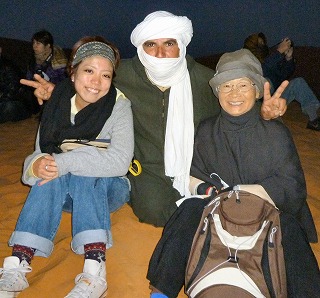 |
|
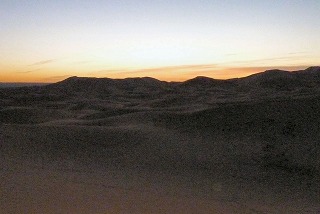 |
|
| Sunrise in the desert |
|
|
We had to wait long even after the sky was beginning to brighten in the
east. It was 6:40 when the sun appeared from the desert. It was not so
dramatic as from the horizon. The sunlight, at the moment, did not come
to us in a straight line on the sand. The sun just rose. How did other
members feel? At least my heart did not beat fast contrary to all expectations.
|
|
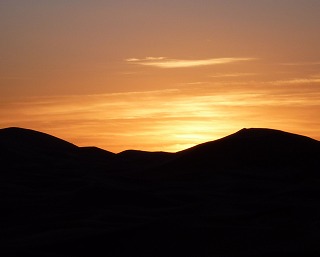 |
|
 |
|
 |
|
|
We decided to go back when the sun began to brighten the whole desert.
The noble members rode on a camel and others had an ascetic walk. But luckily
I did not have such an asceticism as on the way there.
True or not, a camel is born in the fourth month of pregnancy. A white
camel has a good omen. A camel can drink 50 liters at one time and does
not die with no water for one week.
- - - - -
We stopped by at the tent of the Berber on the way and were served by mint
tea. It seemed to be a popular hospitality for this kind of tour, so they
served us with a practical hand and we were relaxed at last. The mint tea
was good with moderate sweetness.
|
|
 |
|
|
It is 470 km from Erfoud to the hotel in Fez.
Our bus ran for 7 hours heading for the north over the Moyen Atlas, taking
a rest for lunch and a couple of toilet rests.
|
|
 |
|
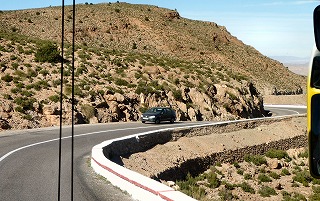 |
|
|
Going over this Moien Atlas was not so thrilling as High (Haut) Atlas two
days ago.
For my such talk, Emiko murmured back in suspicious eyes saying "
Do you think so? I have had more impression here over Moien."
Yes, she is right. According to her, we crossed the pass until Ifrane taking
a rest at Errachidia and Midelt. During this pass, I was relaxed in the
back seat, while Emiko sat in the front seat as she wished and seemed to
enjoy sightseeing for a lot of time.
|
|
|
I take out my favorite iPod. What music shall I listen to? With musics
in the ears, I am indulged in the illusion deeply relaxed on the back seat.
- - - - -
Starting from Marrakech, the first tourist site, until here, we experienced
the traverse over High Atlas, the surrounding area of Ait Benhaddou, Kasbah
Highway, Sahara Desert, ...
At several places they overlapped with the landscapes in the United States
at the time of my studying stay 40 years ago, especially the American south
during the transcontinental drive !
It was hot early September in 1969.
Missouri, Oklahoma, New Mexico, Arizona and California. By way of St. Louis, Navajo Indian Reservation, Painted Desert, the village white mortar houses (Taos Pueblo), the wilderness from Santa Fe to Albuquerque, Grand Canyon, Brice Canyon, Montezuma Ruins, Joshua Tree Desert, ...
And finally we three guys got to the seaside of the Pacific Ocean at Santa
Monica just north of Los Angeles spending 10 days of one-way.
|
|
|
Harboring such illusion, then I begin to listen to Grofe's Grand Canyon
Suite. "On the Trail" soothes my mind. It is the scene a man
is getting down a long winding mountain path of the canyon on a donkey.
But the image of this music does not match the Todgha Gorge. It is a different
view to my regret.
What about the musics of Spanish composers? Some of them might be suitable
to the views of this traverse over the Atlas.
I listen to Falla for a while. "Nights in the Gardens of Spain",
"The Three-Cornered Hat" and "El Amor Brujo".
Next, Sor's guitar music played by Segovia.
None of them do not sit well with me in this situation.
Then, Ravel? Debussy? French composers are not fitted, either.
- - - - -
Without any reason, I chose Piano Concerto No. 1 by Beethoven just when
our bus was going up the winding pass. I could look out over the whole
view from the near valley to distant mountains with no obstacles. The rolling
of the bus sometimes brings me back to the reality, but I am mostly in
my own world.
Strangely this music does not sound odd to my present circumstance. At
least it fits me more than the other musics I listened to until now. The
views are moving and changing with the melody sound of the concertos. I
listened to them through until No. 5 popularly known as "Emperor Concerto",
played by Martha Argerich with Berliner Philharmoniker conducted by Claudio
Abbado.
I listen to No. 1 again, and this time my illusion spreads to the relationship
between the musics and the movies directed by Akira Kurosawa.
|
|
| Movie Title |
Music |
わが青春に
悔いなし |
"Pictures at an Exhibition" by Modest Mussorgsky |
素晴らしき
日曜日 |
"Symphony No. 8, Unfinished Symphony" by Franz Schubert |
| 野良犬 |
"Cuckoo Waltz" and "La Paloma" |
羅生門
(Rashomon) |
"Bolero" by Maurice Ravel |
| 白痴 |
"Night on Bald Mountain" by Modest Mussorgsky |
| 七人の侍 |
"Symphony No. 9, From the New World", by Antonin Dvorak |
| どん底 |
Rakugo "Sokotsu Nagaya" by Kokontei Shinsho |
| 天国と地獄 |
"Piano Quintet in A major, the Trout Quintet", by Franz Schubert,
and "O Sole Mio" |
| 赤ひげ |
"Symphony No. 9 in D minor", by Ludwig van Beethoven |
| どですかでん |
"L'Arlesienne" by Georges Bizet |
乱
(Revolt) |
"Symphony No. 1 in D major" and "The Song of the Earth" by Gustav Mahler |
影武者
(Double of the Samurai) |
"Symphony No. 94 in G major, the Surprise Symphony" by Joseph
Haydn
"Peer Gynt" by Edvard Grieg
"Light Cavalry" by Franz von Suppe |
夢
(Dream) |
"Caucasian Sketches, Suite No. 1" by Mikhail Ippolitov-Ivanov
"Concerto for Orchestra" by Bela Bartok
"Pictures at an Exhibition" by Modest Mussorgsky
"Canon" by Pachelbel
"Horn Concerto No. 3" by Wolfgang Amadeus Mozart
"Prelude for Piano Solo No. 15" by Frederic Chopin |
八月の
狂詩曲 |
"Rose on the Heath" by Franz Franz Schubert
"Stabat Mater" by Antonio Lucio Vivaldi |
| まあだだよ |
"The Harmonic Inspiration, No. 9" by Antonio Lucio Vivaldi |
|
|
"Akira Kurosawa, Sound and Pictures"
by Yuichiro Nishimura (Rippu Publishing) |
|
|
This table is what I referred to in the essay of the Daibosatsu- toge climbing
during the typhoon 11 years ago.
Director Kurosawa does not use a music showing any present scene. For example,
in the tense atmosphere of the movie 野良犬 (Stray Dog) "Cuckoo Waltz"is
a background music. "Solveigs Song" of "Peer Gynt"
in the case of 影武者 (Double of the Samurai).
In a similar feeling of Kurosawa's movies, I enjoyed the bgm through my
iPod.
|
|
|
We stopped by at a town Ifrane before 1-hour drive to Fez, where we strolled
around the park for 30 minutes. The atmosphere there was totally different
from the noise in Marrakech or the views and historic ruins until Sahara
Desert. It was just like a local town in Eastern Europe.
|
|
 |
|
|
Royal Mirage, the hotel in Fez, was much better compared to the travel
fee. I felt it chic and for high society.
|
|
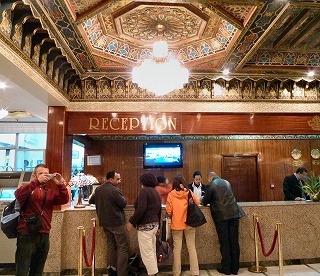 |
|
| Sahara Desert, Other Pictures |
| From Erfoud to Fez, Pictures on the Way |
| ………………………… |
Sahara Marathon
Marathon des Sables, MDS |
|
|
Shame on me. I knew the name only. I take a note by the help of Wikipedia
article.
|
|
It is said to be held south of Route des Kasbahs, so it is probably not
far south from where we saw the sunrise. In the middle of that desert the
Ultramarathon of about 230 km is held every year.
The following explanation is from English Wikipedia.
Sahara Marathon is a six-day, 252 km (156 ml) ultramarathon, which is approximately
the distance of six regular marathons. The longest single stage (2009)
is 91 km (57 ml) long.
This multiday race is held every year in southern Morocco, in the Sahara
Desert. It has been called the toughest foot race on Earth. The first event
of the Marathon started in 1986.
The marathon was the brainchild of French concert promoter Patrick Bauer
who in 1984 traversed the Sahara Desert on foot and alone. He covered 350
km (214 ml) in 12 days without encountering a single oasis or desert community
along the way.
Two years later in 1986 the first Marathon des Sables was run. Twenty-three runners participated in the race with Bernard Gaudin
and Christiane Llumere, both from France, finishing as the winning man
and woman.
By 2009 over 1,000 runners participated in the event and the Solidarite
Marathon des Sable association was created. The aim is to develop projects
to assist children and disadvantaged populations in the domains of health,
education and sustainable development in Morocco.
In 2017, two new Marathon des Sables events will take place for the first time: the Half Marathon des Sables on Fuerteventura in the Canary Islands in September, and another full-length
Marathon des Sables event in Peru in November.
|
|
| Two years ago in 2008, 801 people took part in this marathon including
10 Japanese people. Mr. Kanpei Hazama, a talent, was one of them, who ran
the whole distance at the time of 51 hours 46 minutes 5 seconds. |
|
|
Just an aside, Rallye Dakar (Dakar Rally), which was formerly Rallye Paris-Dakar
(Paris-Dakar Rally). It is said to be the severest motor-sport competition
in the world.
From last year, the place moved to South America, where the competition
is held circling Chile by starting from Buenos Aires, the capital of Argentina.
But until then it had been held along the following route every year.
Starting from Paris, France, via Barcelona, Spain, then running over to
African Continent, and finally Dakar, the capital of Senegal. Total distance:
12,000 km.
One of its sections was this Sahara Desert between Erfoud and the south
of Ouarzazate.
|
|
| Reading: 22:02 |
|

